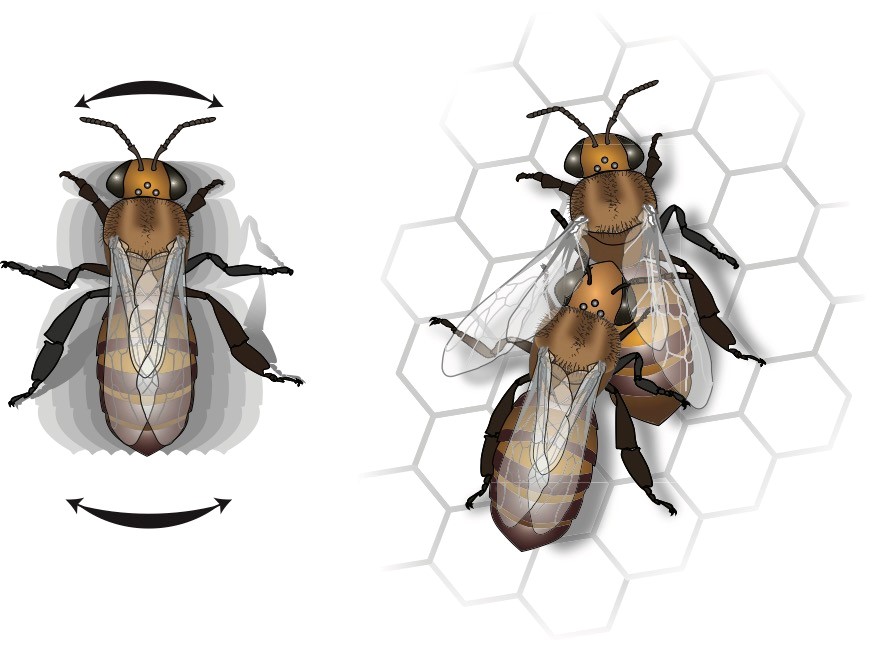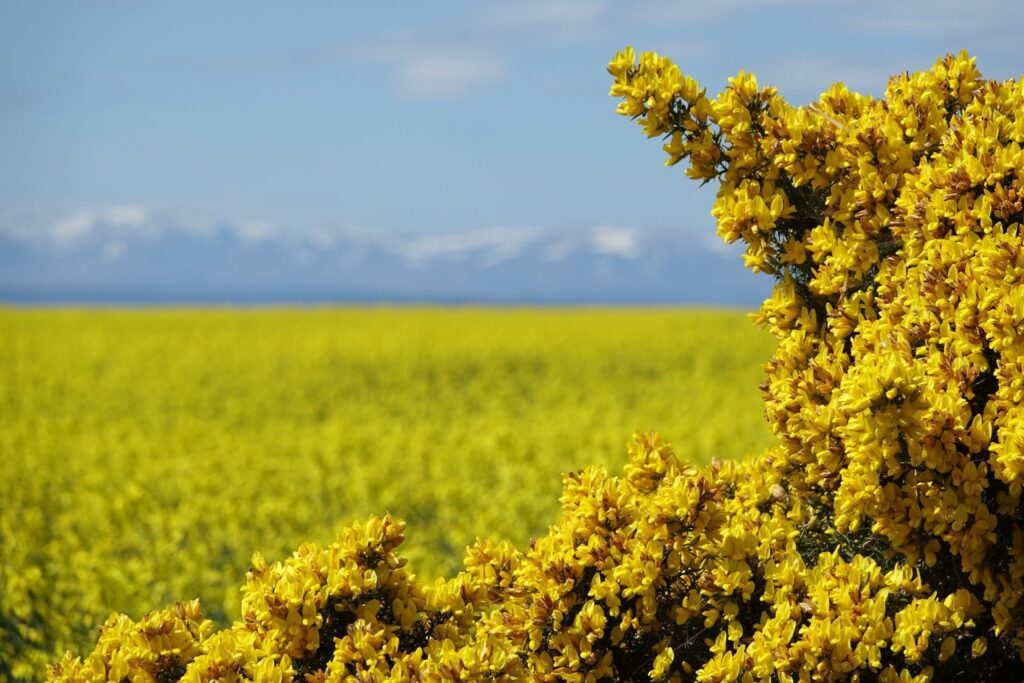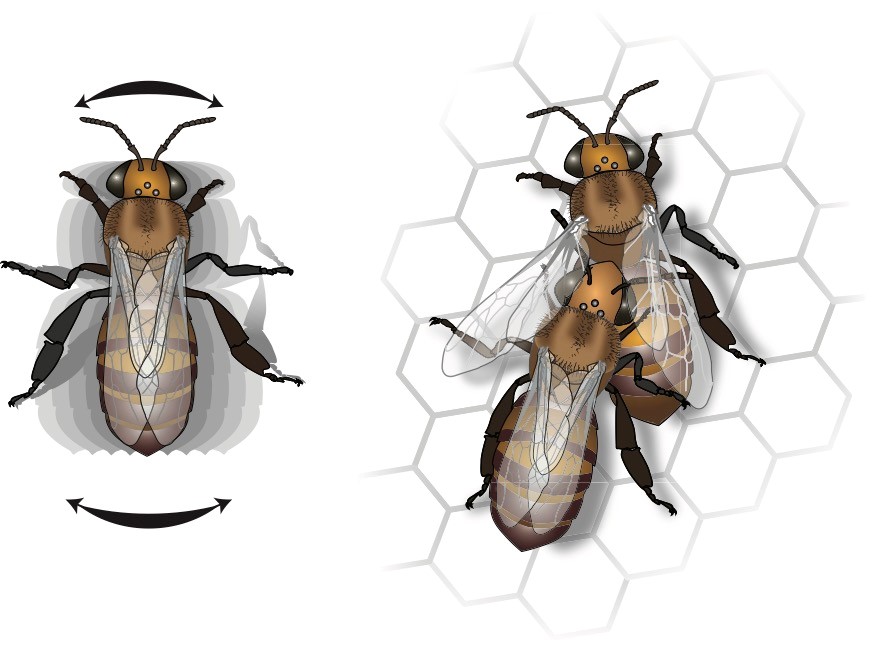
Introduction

I don’t know about your swarm season, but mine got off to a flying start on 7th May exactly a week earlier than last year. I know this because I keep a nature journal with 5 years on each page for easy comparison. A beekeeper friend reminded me that, despite the long, wet winter, the flowering season is at least a couple of weeks earlier this year. We’ve had the most tremendous crop of dandelions than anyone around here can remember. After a month, they are going to seed and the bees have turned their attention to the fields of dazzling oil seed rape a quarter of a mile away as the bee flies.
All six productive colonies have been divided in some way for swarm control having produced queen cells with eggs and larvae in beds of rich royal jelly. Mostly, I have used the nucleus method and removed the queen and several frames of brood with stores, pollen, and an empty drawn comb for the queen to lay in.
For one colony I made a traditional Padgen artificial swarm and got the queen and the flying bees onto a box of new frames and foundation (on the original site) with a couple of already drawn combs.
Right now, I am using a swarm as a wax factory to draw out comb on new foundation for future use. After 3 days, I removed 5 freshly drawn frames and replaced them with frames of foundation.
Plans Fail
As often happens in beekeeping, plans fail. I tried to keep a colony going on a single brood box as a demonstration colony for new beekeepers. The idea was for us to inspect weekly until it was time for swarm control when I was going to show them how to do a Pagden artificial swarm with the Hedden variation whereby, after a week, you move the parent colony with brood to the other side of the box with queen and flying bees on new comb. You do this so that the flying bees from the brood box, that have just progressed to foraging, will fly into the box with the queen and reduce congestion even further in the brood box.
Despite giving them three supers they decided to swarm, but well before the usual timing when the first queen cell is sealed. I checked carefully last Wednesday and there were no signs of royal jelly in queen cups with either eggs or larvae. You need to shake bees off frames to get a clear view of frames and hidden cells.
On Monday it was still, warm, and sunny, and by 11 am a cloud of bees erupted with a roar from the chosen hive and settled on the back of the back garden hedge. Luckily, Linton was home to get the ladder and collect them for me. When I checked the parent colony next day after they settled down, I found only a few queen cups with royal jelly and eggs. The most mature cell had a larva of about 3 days age and a couple of days off capping.
Grooming
This week, I noticed bees grooming each other on the landing board of one hive. The groomer was vigorously working around the base of the other bees’ wing. Have you seen this behaviour? This week, Professor Tom Seeley shares another chapter from his newly published Piping Hot Bees with us and he explains grooming behaviour. https://www.beelistener.co.uk/beekeeping/piping-hot-bees-reviewed/Thank you once again Tom for your contributions to the Beelistener blog. BTW, the photograph of the bee on Himalayan balsam was taken the day Tom showed me how to interpret the waggle dance inside the observation hive and follow the bees to their forage source by the river Nairn. https://americanbeejournal.mydigitalpublication.com/articles/eavesdropping-in-the-apiary-learning-where-your-bees-are-foraging-by-reading-their-dances
Autogrooming
A worker honey bee is certainly adept at grooming herself (“autogrooming”), but there are some places on her body that she cannot clean thoroughly on her own. These places include the posterior surfaces of her head and the dorsal surfaces of her thorax, especially the “hinges” at the bases of her wings. Bit of debris can get lodged by accident in these hard-to-groom spots, especially when a bee is inside the hive and bits of cell cappings and such fall onto her. The same sort of thing can happen to a forager when she is outside the hive. Indeed, some plants, such as Himalayan balsam (Impatiens glandulifera) have anthers that deposit pollen in a bee’s hard-to-groom spots by “design” (Fig. 1). Doing so make the bee a more effective pollinator for these plants. So, there are times when a worker bee decides that she needs help with her grooming. She then produces a conspicuous call for assistance: the grooming invitation dance.

Fig. 1. A worker honey bee collecting pollen from a flower of Himalayan balsam (Impatiens glandulifera) in Scotland. The anthers in the flowers of this species deftly deposit their pollen grains atop a worker bee’s thorax, where she cannot remove them by grooming. The light strip atop her thorax show this limitation in a bee’s ability to groom herself. Photo by Tom Seeley.
To the best of my knowledge, the first detailed description of the grooming invitation dance was written by Mykola H. Haydak (1898-1971). He was born in Ukraine (Kiev) and came to the U.S. in 1930. He earned his PhD at the University of Wisconsin in 1933, and then worked as a professor of entomology at the University of Minnesota until 1966. He wrote as follows in the September 1945 issue of the American Bee Journal:
“Occasionally a bee feels the need of being cleaned. In such cases it performs a special dance, consisting of a rapid stamping of the legs and a rhythmic swinging of the body to the sides. At the same time the bee rapidly raises and lowers the body and tries to clean around the bases of the wings with the middle pair of the legs. Such a “shaking” dance may be observed any time during the year, even during the winter. Usually the bee which is closest to the dancer touches the latter with its antennae and begins to clean the dancer. With the mandibles widely spread the “cleaner” touches the thorax of the dancer just under the bases of the wings. As soon as the dancer feels the touch of the cleaner, it stops dancing, slowly spreads out the wings of one side, bends the abdomen and curves the body to the side and somewhat upward as if accommodating the cleaner. The latter works very energetically. Its antennae are held close to the mandibles. With shearlike motions of the mandibles it cleans around the base of the wings.”
Haydak was not able to film the grooming invitation dance, so he was not able to make a precise description of the movements that make up this behavior. Also, he did not investigate what causes a worker to perform this dance.
The most recent investigation of the form and function of the grooming invitation dance was made in 2002, by an undergraduate student at Cornell University, Benjamin B. Land. Ben began his study by making a fine-grained description of the movements of a worker bee’s body when she produces the grooming invitation dance. This analysis involved making close-up, digital video recordings of 25 worker bees producing the grooming invitation dance and then analyzing these recordings by means of slow-motion playback.
Ben’s analysis of his video recordings yielded several clear findings. First, it revealed that when a bee produces the grooming invitation dance, she stands rooted in one place with her six legs widely spread and with each leg’s tarsal claws firmly gripping the comb. This stance makes sense; it prevents her from falling off the comb as she throws her body mightily and rapidly (4 times per second) from side to side on the vertical surface of a comb (Fig. 2). Second, it documented that grooming invitation dances are short-lived. Their average duration is just 9 seconds. Third, it showed that when a bee performs a grooming invitation dance, she may pause briefly to groom herself. I suspect that when a bee makes a pause in her grooming invitation dance to groom herself, she is trying to remove something especially troublesome from her body. She can’t wait for help!

Fig. 2. Left: The grooming invitation dance. Right: The allogrooming response that it elicits. This grooming by another bee almost always involves the groomer mounting the groomee as soon as she has stopped dancing and has spread one or both wings. Note: when a bee grooms another bee, the bee doing the grooming often tilts her head so that her mandibles point forward instead of downward. This is why the heads of the groomed bee and the groomer bee look so different in the right-hand part of this figure.
The second stage of Ben’s investigation of the grooming invitation dance was an experimental test of the hypothesis that debris lodged in the wing “hinges” of a worker bee will stimulate her to perform this dance. To execute this experiment, Ben worked with a colony living in a small observation hive from which he could gently remove the sheet of glass that covered one of its sides. After doing so, he selected at random a worker bee to watch. He did not touch the chosen bee, but he did puff onto her thorax (from the tip of a slender glass pipette) either some chalk dust or some clean air. He then steadily watched this bee’s behavior for 10 minutes, to see if she groomed herself, or performed the grooming invitation dance, or did both. Ben repeated this experimental procedure with 60 worker bees.
Ben’s experiment yielded crystal-clear results. Of the 30 bees that received a puff of chalk dust, 28 groomed themselves and 15 performed a grooming invitation dance. Of the 30 bees that received a puff of clean air, only 6 groomed themselves and just 1 performed a grooming invitation dance. These results strongly support the idea that debris on a worker bee’s body will induce her to perform the grooming invitation dance.
I will end this essay by making a speculation about the evolutionary origins of the grooming invitation dance. Because the form of this dance resembles the form of a worker bee’s behavior when she grooms herself, I suspect that the precursor (ancestral form) of the grooming invitation dance is the set of body movements that worker honey bees make when they perform autogrooming. These body movements are a reliable indicator (a cue) that the bee making them senses that her body needs grooming. Then, at some point in the past, worker bees evolved an allogrooming response to fellow workers that were grooming themselves especially strongly, i.e., to bees that were having difficulty getting themselves clean.
Since worker bees that are living together are nest mates, both the bee receiving the grooming and the bee giving the grooming will benefit from this social response. Thus, the stage was set for natural selection to favor refinements both in signal production (exaggeration of the self-grooming behavior) and in signal reception (greater sensitivity and responsiveness to bees producing the self-grooming behavior). The eventual result is, I believe, the remarkable grooming invitation dance and the reliable allogrooming response to this dance that we can enjoy watching today.
References:
Haydak, M.H. 1945. The language of the honey bees. American Bee Journal 85: 316-317.
Land, B.B. and T.D. Seeley. 2004. The grooming invitation dance of the honey bee. Ethology 110: 1-10.

Thank you Ann, I really enjoyed the conversation and need to get his book.
That’s good, Rick. Thank you for commenting.